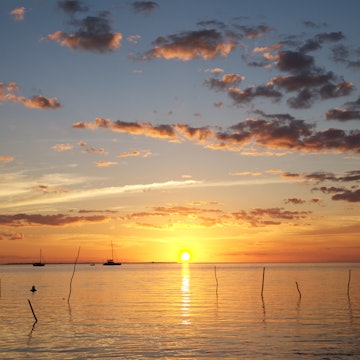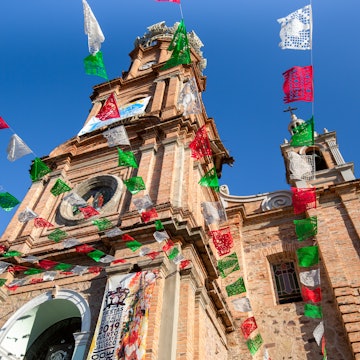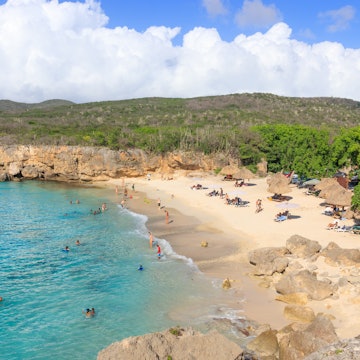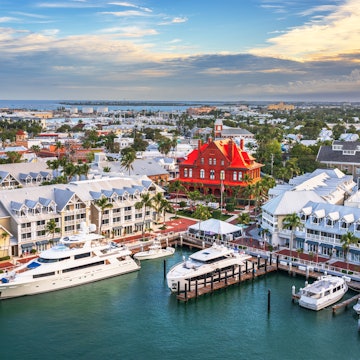

Gushing Tumpak Sewu is one of Indonesia's most dramatic waterfalls. Alenik Eremeeva/Shutterstock
The Indonesian city of Malang is the perfect place to base yourself to see the very best of what East Java has to offer, and the gushing Tumpak Sewu waterfall is one of the undisputed highlights. Even on a short trip, you can climb the towering Gunung Bromo volcano, wander Malang’s colonial-era streets, and feel the elemental force of the Tumpak Sewu cascade.
Tumpak Sewu is among the most famous of Indonesia’s waterfalls, and it’s definitely the most impressive. The name Tumpak Sewu means “Thousand Waterfalls,” and with hundreds of sub-falls cascading over the rim of a huge semicircular cliff, it’s easy to understand how it got its name.
Visiting is a once-in-a-lifetime experience. White water tumbles from the edge of a 120m-high (394ft) drop-off into a canyon lost in the mists far below. It’s a humbling sight, and hiking along the bottom of the almost primordial gorge below the falls only adds to the drama.
Here’s everything you need to know to get more from your visit to Tumpak Sewu.
When should I go to Tumpak Sewu?
The waterfall is open to visitors from 7am to 3pm. Aim to arrive as close to opening time as possible in the morning, so you have time to soak up the magic of the falls before the crowds arrive. If you come on an organized tour, you’ll likely arrive mid-morning, when the falls are already quite busy.
The rainy season in Java runs from November to April and this is perhaps the most spectacular time to visit Tumpak Sewu. Seeing all this extra water surging over the falls is an extraordinary experience. However, the best way to see the falls is by hiking the canyon to the base, and this trail may be closed if there has been too much rain.
Many visitors come in the dry season, from April to October, when you can rely on the trail being open. Visiting just after the end of the rains is a good compromise – the path into the valley can be slippery underfoot, but there’ll still be plenty of water thundering over the cliff edge.

How much time should I spend at Tumpak Sewu?
Most people visit Tumpak Sewu as a day trip from Malang, either on an organized tour or with their own transport. If you come with a chartered car and driver or a rented scooter, you’ll have the freedom to set your own schedule, but remember to factor in the travel time from Malang – around two hours in each direction.
It’s also possible to reach Tumpak Sewu by taking the bus from Malang to Lumajang City, then hiring a taxi to reach the falls, but buses are infrequent and stop by mid-afternoon. If you plan to try this, leave as early as possible in the morning.
What’s the best way to see Tumpak Sewu?
The trail to the base of the Tumpak Sewu falls is easy to follow, and both the Lumajang viewpoint to the east and the Coban Sewu viewpoint to the west are well signposted from the Malang–Lumajang road. However, while the Coban Sewu viewpoint offers great views, it isn’t advisable to try to hike down to the bottom of the gorge from this side – hike down instead from the Lumajang viewpoint.
How much do tickets cost?
The entry fee to the Lumajang viewpoint is 20,000Rp (US$1.20), plus parking fees for your car or motorcycle if you come with your own transport. There’s an additional 50,000Rp (US$3) fee to hike down into the gorge, and extra fees along the trail and at the Copan Sewu viewpoint, so bring some cash when you visit.
What should I eat and drink at Tumpak Sewu?
If you come on an organized tour, they will usually provide lunch – often an Indonesian meal such as nasi campur (rice with assorted sauces and sides). If you arrive under your own steam, there are food stalls near the viewpoints.

What are the top things to see and do?
To get the best from a trip to Tumpak Sewu, see the falls from above (from the Lumajang or Coba Sewu viewpoints) and below, from the trail at the bottom of the gorge.
Lumajang Viewpoint
Visiting the most popular viewpoint at Tumpak Sewu is easy. Park near the entrance, pay the fee at the ticket booth, then follow the footpath. This is the most popular spot to view the waterfall, and you can take some spectacular photos from here, with white water bubbling over the lip of the cliff into the abyss.
Early morning is the best time to visit, as the clouds of mist rising from the canyon below create some truly eerie light effects. A small track leads from the main viewpoint to another lookout with unobstructed views, but it’s best avoided because of the risk of falling.
If you have a drone, the Lumajang viewpoint is the best place to launch it from. Once airborne, you can get some amazing shots with the curved curtain of the falls in the foreground and the brooding peak of the 3676m (12,060ft) Gunung Semeru volcano in the background.
Coban Sewu Viewpoint
If you’re traveling here from Malang, you’ll come across signs pointing to Coban Sewu before you see the signs to the main Lumajang viewpoint. It’s worth paying the additional entry fee to view the cascades from the Coban Sewu side, if only to see the falls from a different angle.
It’s less crowded here too, as most tourists head straight for the Lumajang viewpoint. While you can access the base of the falls from the Coban Sewu side, this is not advisable as the track and ladders here are extremely dangerous compared to those on the Lumajang side.

The Canyon Hike
As wonderful as the view is from the top of the drop-off, the true joy of visiting Tumpak Sewu is the hike to the base of the falls. Viewed from the bottom, the falls descend like a supersized power shower, pounding into the canyon and filling the air with noise and vapour.
The safest route to the valley floor starts to the left of the Lumajang viewpoint area. The hike begins along a muddy track, before descending rapidly on stairs, steel gantries, wooden walkways and ladders. Note that this hike can be tough going, so wear sturdy shoes and follow the path carefully.
About two-thirds of the way down, the ladders end, and you’ll find yourself clinging to a rope as you make your way down a rocky slope with a rushing waterfall all around you. When you reach the canyon floor, follow the Tumpak Sewu trail (there’s an extra fee as you move into a new village area) to reach the basin at the bottom of the falls.
At the end of the track, you can stand in the middle of a curving curtain of water made up of hundreds of tall rivulets of white water, plunging into a massive, mossy, spray-filled cauldron of rock. You’ll get very wet, but the spectacle is well worth the effort.
Goa Tetes Falls & Caves
Following the canyon in the other direction – away from the main cascade – you’ll reach the Goa Tetes falls, another set of beautiful cascades that flow down an orange-coloured cliff face, forming pools at the base that you can swim in.
If you follow the track further, taking extra care on this steep and slippery section, you can climb to the Goa Tetes caves – a set of eerie-looking, mouth-like caverns eroded by the water gushing down the cliff face. From the caves, you can continue following the trail up and out of the canyon.
Is Tumpak Sewu accessible?
Visitors with limited mobility will have difficulty reaching Tumpak Sewu. If you come on an organized tour, it may be possible (with some assistance) to reach the viewpoints at the top of the falls, but the canyon trail is steep and precarious, even for able-bodied hikers.
This article was adapted from Lonely Planet’s Indonesia guidebook, published in July 2024.
















